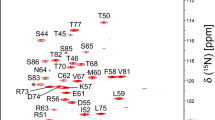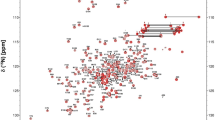Abstract
Translation initiation in eukaryotes is an early step in protein synthesis, requiring multiple factors to recruit the ribosomal small subunit to the mRNA 5’ untranslated region. One such protein factor is the eukaryotic translation initiation factor 4B (eIF4B), which increases the activity of the eIF4A RNA helicase, and is linked to cell survival and proliferation. We report here the protein backbone chemical shift assignments corresponding to the C-terminal 279 residues of human eIF4B. Analysis of the chemical shift values identifies one main helical region in the area previously linked to RNA binding, and confirms that the overall C-terminal region is intrinsically disordered.


Similar content being viewed by others
Data Availability
The assignments have been deposited to the BMRB under accession codes 51952, 51953 and 51957.
References
Delaglio F, Grzesiek S, Vuister GW et al (1995) NMRPipe: a multidimensional spectral processing system based on UNIX pipes. J Biomol NMR 6:277–293
Fleming K, Ghuman J, Yuan X et al (2003) Solution structure and RNA interactions of the RNA recognition motif from eukaryotic translation initiation factor 4B. Biochemistry 42:8966–8975
García-García C, Frieda KL, Feoktistova K et al (2015) Factor-dependent processivity in human eIF4A DEAD-box helicase. Science 348:1486–1488
Jackson RJ, Hellen CUT, Pestova TV (2010) The mechanism of eukaryotic translation initiation and principles of its regulation. Nat Rev Mol Cell Biol 11:113–127
Merrick WC (2015) eIF4F: a retrospective. J Biol Chem 290:24091–24099
Méthot N, Pause A, Hershey JW, Sonenberg N (1994) The translation initiation factor eIF-4B contains an RNA-binding region that is distinct and independent from its ribonucleoprotein consensus sequence. Mol Cell Biol 14:2307–2316
Naranda T, Strong WB, Menaya J et al (1994) Two structural domains of initiation factor eIF-4B are involved in binding to RNA. J Biol Chem 269:14465–14472
Özeş AR, Feoktistova K, Avanzino BC, Fraser CS (2011) Duplex unwinding and ATPase activities of the DEAD-box helicase eIF4A are coupled by eIF4G and eIF4B. J Mol Biol 412:674–687
Rogers GW Jr, Richter NJ, Lima WF, Merrick WC (2001) Modulation of the helicase activity of eIF4A by eIF4B, eIF4H, and eIF4F. J Biol Chem 276:30914–30922
Rozovsky N, Butterworth AC, Moore MJ (2008) Interactions between eIF4AI and its accessory factors eIF4B and eIF4H. RNA 14:2136–2148
Sen ND, Zhou F, Harris MS et al (2016) eIF4B stimulates translation of long mRNAs with structured 5’ UTRs and low closed-loop potential but weak dependence on eIF4G. Proc Natl Acad Sci U S A 113:10464–10472
Shahbazian D, Roux PP, Mieulet V et al (2006) The mTOR/PI3K and MAPK pathways converge on eIF4B to control its phosphorylation and activity. EMBO J 25:2781–2791
Shahbazian D, Parsyan A, Petroulakis E et al (2010) eIF4B controls survival and proliferation and is regulated by proto-oncogenic signaling pathways. Cell Cycle 9:4106–4109
Shen Y, Bax A (2013) Protein backbone and sidechain torsion angles predicted from NMR chemical shifts using artificial neural networks. J Biomol NMR 56:227–241
Tamiola K, Acar B, Mulder FAA (2010) Sequence-specific random coil chemical shifts of intrinsically disordered proteins. J Am Chem Soc 132:18000–18003
Wang Y, Begley M, Li Q et al (2016) Mitotic MELK-eIF4B signaling controls protein synthesis and tumor cell survival. Proc Natl Acad Sci U S A 113:9810–9815
Acknowledgements
The authors would like to thank Estelle Morvan, Axelle Grélard, and the IECB biophysical and structural chemistry facility (CNRS UAR3033, Inserm US001, Univ. Bordeaux), for NMR support and access to the 700 MHz spectrometer. We thank Jean-Michel Blanc and the IECB biochemistry facility for assisting the preparation of the initial eIF4B CTR plasmid.
Funding
This work was supported by grants from the Fondation pour la Recherche Médicale (AJE20171239128 to MA), Junior Chair IdEx Univ. Bordeaux (OPE-2018-0405 to MA), ANR JCJC (DISTINCT: ANR-20-CE11-0007 to MA), and recurrent funds from the French National Institute of Medical Research (Inserm; MA, CDM).
Author information
Authors and Affiliations
Contributions
SR created the plasmids. SR, VT and CABT expressed and purified the protein samples. CDM collected and processed the NMR data. SM, CABT and CDM analyzed the NMR data. MA and CDM directed the project and wrote the manuscript.
Corresponding authors
Ethics declarations
Competing interests
The authors declare that they have no competing conflict of interest.
Ethics approval and consent to participate
Not applicable.
Consent for publication
All authors have approved the submission of the manuscript.
Additional information
Publisher’s Note
Springer Nature remains neutral with regard to jurisdictional claims in published maps and institutional affiliations.
Rights and permissions
Springer Nature or its licensor (e.g. a society or other partner) holds exclusive rights to this article under a publishing agreement with the author(s) or other rightsholder(s); author self-archiving of the accepted manuscript version of this article is solely governed by the terms of such publishing agreement and applicable law.
About this article
Cite this article
Mondal, S., Rousseau, S., Talenton, V. et al. Backbone resonance assignments of the C-terminal region of human translation initiation factor eIF4B. Biomol NMR Assign 17, 199–203 (2023). https://doi.org/10.1007/s12104-023-10141-7
Received:
Accepted:
Published:
Issue Date:
DOI: https://doi.org/10.1007/s12104-023-10141-7




